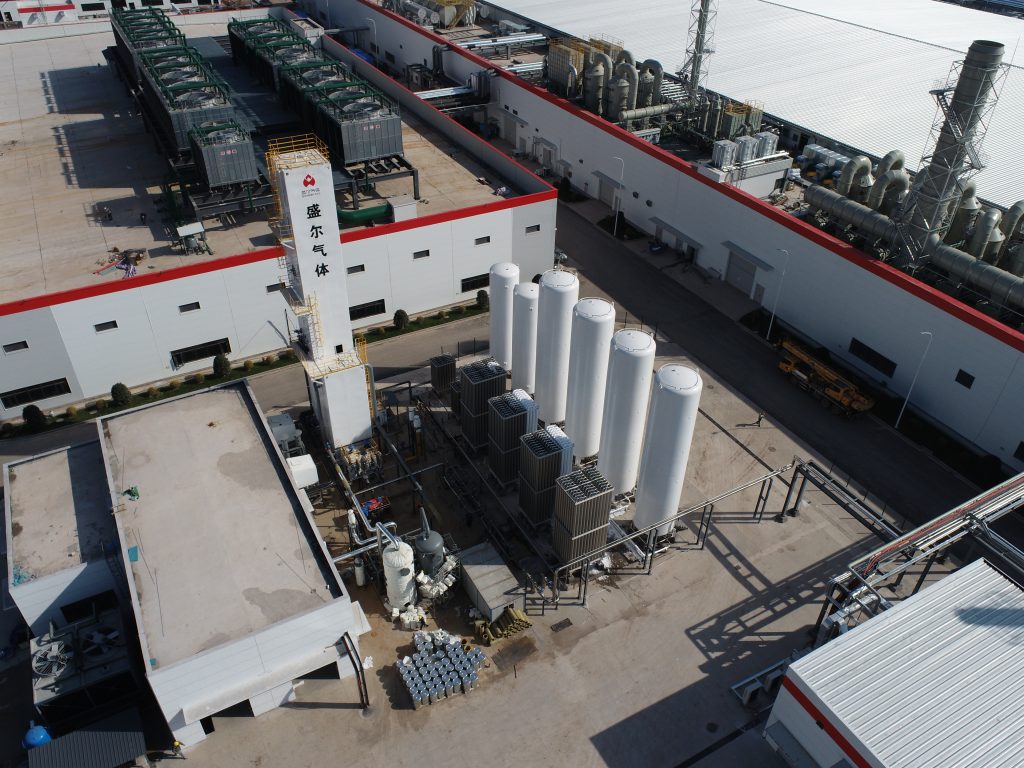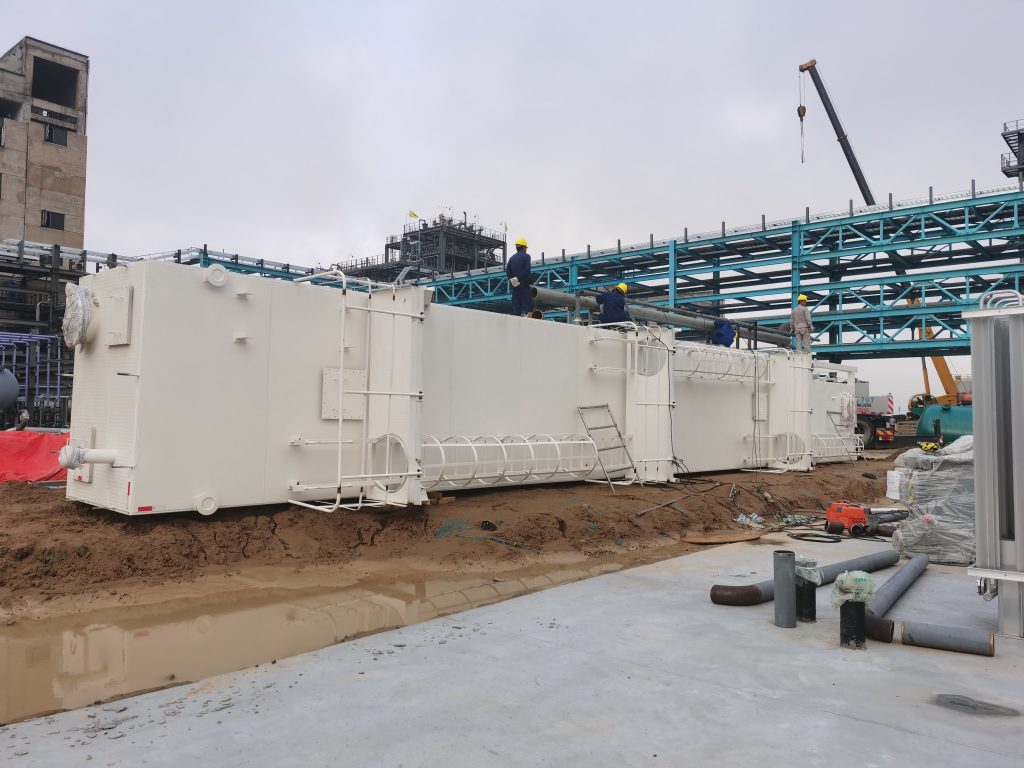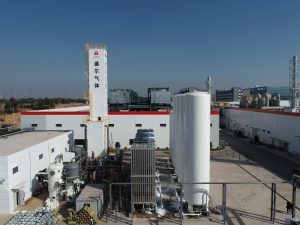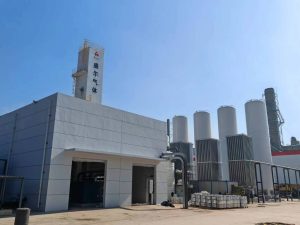Introduction
Container-glass production relies on high-temperature furnaces to melt raw materials into bottles, jars, and other glass containers. A critical factor in modern glass furnace operations is the supply of high-purity oxygen to support combustion. Traditionally, furnaces drew combustion air from the atmosphere, which is mostly nitrogen. However, nitrogen does not aid combustion and carries away heat, reducing efficiency. To overcome this, many container-glass plants are turning to cryogenic ASU (Air Separation Unit) technology for on-site oxygen supply. A cryogenic ASU is an industrial gas system that extracts oxygen from air at very low temperatures, providing a continuous stream of nearly pure oxygen. By delivering oxygen of high oxygen purity directly to the furnace, cryogenic ASUs enable more efficient and cleaner melting processes. This article explores how cryogenic ASUs work in container-glass manufacturing, their benefits for glass furnace operations, and how they compare to other oxygen generation methods, with a focus on technical parameters and energy performance.

The Role of Oxygen in Container-Glass Furnace Operations
Oxygen is essential for fuel combustion, and raising the oxygen concentration in a glass furnace dramatically improves efficiency. In conventional air-fired furnaces, air’s 78% nitrogen content is essentially a thermal ballast – it absorbs heat and exits through the flue without contributing to combustion. By using an oxygen-enriched or oxy-fuel combustion process, container-glass plants can eliminate most of this nitrogen. In full oxy-fuel furnaces, burners are fed with natural gas (or other fuel) and nearly pure oxygen from an ASU instead of air. Without excess nitrogen, the flame burns hotter and more steadily, allowing faster and more uniform heating of the glass batch. This oxygen supply strategy has several proven advantages: fuel consumption can drop by roughly 20–25%, energy efficiency improves significantly, and furnace waste-gas volume is reduced by more than half. Lower flue gas volumes and higher heat transfer efficiency translate to lower overall energy use in glass furnace operations. Emissions are also dramatically reduced – particularly nitrogen oxides (NOx), which can fall by 70–90% because NOx formation is driven by nitrogen in air at high flame temperatures. Many container-glass manufacturers report around 20% lower carbon dioxide emissions as well, thanks to reduced fuel usage and more complete combustion. Beyond efficiency and emissions, oxygen-enriched combustion can improve glass quality and melting control. The more stable, high-temperature flame achieved with oxy-fuel technology minimizes temperature fluctuations in the melt, reduces batch carry-over (unmelted particles), and can even prolong furnace life by lowering peak flame temperatures at the refractories. Overall, integrating a dedicated oxygen source fundamentally enhances container-glass production, and cryogenic ASUs are the primary solution to provide that oxygen at the required scale and purity.
How Cryogenic ASUs Work in Industrial Gas Systems
A cryogenic ASU is a large-scale industrial gas system designed to separate air into its primary components: oxygen, nitrogen, and occasionally argon. It operates on the principle of cryogenic distillation, taking advantage of different boiling points of gases at extremely low temperatures. Here’s how it works: First, ambient air is drawn into the ASU and compressed to a high pressure by an air compressor. The compressed air is then cooled and passed through purification units to remove moisture, carbon dioxide, and hydrocarbons – impurities that would freeze solid in the cold temperatures ahead. Next, the clean, dry air is directed into a heat exchanger and cooled to sub-zero cryogenic temperatures (around -300°F / -185°C) until it liquefies. The liquefied air enters a distillation column system inside a tall insulated cold box. In this double-column (low-pressure and high-pressure) distillation setup, oxygen and nitrogen separate based on their boiling points: oxygen (boiling ~ -183°C) liquefies at a higher temperature than nitrogen (boiling ~ -196°C). As the mixture boils and re-condenses on trays inside the column, oxygen concentrates in the lower part as a liquid, while nitrogen rises as a vapor. The result is two primary product streams – one of high-purity oxygen and one of high-purity nitrogen. The oxygen stream can be drawn off as a gas or liquid. In a typical on-site configuration for a glass plant, gaseous oxygen (often 95–99.5% oxygen purity) is delivered from the ASU cold box to the furnace through pipelines at the desired pressure. The ASU keeps producing oxygen continuously to meet the furnace demand. The other stream is nitrogen, which is produced in excess (since air contains four times more nitrogen than oxygen by volume). Nitrogen recovery from a cryogenic ASU provides nitrogen gas that can be used elsewhere in the plant or stored as liquid. Some ASU designs also have an additional column to extract argon (present ~1% in air), but argon is usually not required for glass production and may be vented or captured only in larger plants. The entire ASU is highly automated, with control systems maintaining the proper temperatures, pressures, and flows to ensure consistent purity and output. Cryogenic ASUs are known for their reliability; once started, they run continuously for months or years with minimal downtime. This reliability is vital for container-glass plants, as the glass furnace operates 24/7 and depends on a steady oxygen feed. In terms of integration, the ASU becomes the on-site source of oxygen supply, often complemented by a backup system (such as a reserve liquid oxygen tank) to keep the furnace running if the ASU needs maintenance. Overall, the cryogenic ASU is the workhorse that enables large-scale oxygen-on-demand, making it a cornerstone of modern container-glass production facilities aiming for higher efficiency and lower emissions.

Benefits of Cryogenic ASU in Container-Glass Production
Implementing a cryogenic ASU on-site offers numerous benefits for container-glass manufacturers. Firstly, it provides an independent and continuous oxygen supply. This security of supply means the plant is not reliant on delivered oxygen or pipeline networks, which can be especially important in remote locations or where supply disruptions must be avoided. The on-site ASU generates oxygen as needed, matching the furnace’s consumption and allowing stable operations. Secondly, the oxygen from a cryogenic ASU has high purity (typically 99% or above, if required), ensuring optimal combustion performance. High oxygen purity allows the furnace to run in full oxy-fuel mode, maximizing the efficiency gains and emissions reductions discussed earlier. By contrast, lower-purity oxygen (such as the ~90–95% from some non-cryogenic generators) introduces some nitrogen into the flame, slightly reducing the benefits. Thus, the cryogenic ASU enables the best performance for glass furnace operations by virtually eliminating nitrogen dilution. Another key benefit is scalability and capacity. Cryogenic ASUs can produce huge volumes of oxygen, from a few hundred Nm³/hour in small units up to tens of thousands of Nm³/hour in large industrial plants. This makes them well-suited for container-glass furnaces of all sizes, including large furnaces melting hundreds of tons of glass per day that have very high oxygen demands. Non-cryogenic systems like PSA (Pressure Swing Adsorption) are generally limited to smaller scales. With a cryogenic plant, as glass production grows or new furnaces are added, the oxygen production can be scaled up accordingly (either by expanding the ASU or adding additional modules) to meet future needs. The presence of an on-site ASU also means co-product gases are available. The nitrogen recovery aspect of a cryogenic ASU can be leveraged in a glass plant – for example, nitrogen gas can be used to purge and inert certain processes. In container-glass manufacturing, nitrogen is often used in cooling and annealing phases to prevent oxidation of the glass or equipment. An inert nitrogen atmosphere in the annealing lehr (the slow cooling conveyor oven for finished glass) can help avoid discoloration or surface oxidation on some glass products. Nitrogen can also be used to shield molten glass from ambient air at certain transfer points, or for general purging of flammable gases. Having a built-in source of nitrogen from the ASU eliminates the need for separate nitrogen generators or deliveries, adding convenience and cost savings. Moreover, the surplus nitrogen can be liquefied and stored or even sold to other industries if it exceeds on-site needs. Finally, on-site cryogenic ASUs often improve a plant’s overall energy efficiency and sustainability profile. While the ASU itself consumes electrical energy to produce oxygen, the resulting efficiency gains in the furnace (reduced fuel usage per ton of glass) often offset a significant portion of this energy cost. In some cases, particularly when waste heat recovery is employed, the net energy efficiency of the glass production process improves despite the added electrical load. From an environmental standpoint, the ability to cut NOx and CO₂ emissions through oxy-fuel combustion helps glass manufacturers meet strict air quality regulations and corporate sustainability targets. In summary, a cryogenic ASU is an enabling technology that provides reliability, performance, and flexibility – ensuring a glass plant can produce high-quality glass efficiently while controlling its emissions and operating costs.
Energy Efficiency and Oxygen Purity Considerations
It’s important to address the energy requirements of a cryogenic ASU and how they relate to oxygen purity. Cryogenic air separation is an energy-intensive process: compressing and cooling air to cryogenic temperatures and then distilling it consumes a significant amount of electricity. Typically, a modern cryogenic ASU might require on the order of 0.4 to 0.6 kilowatt-hours of electricity per Nm³ of oxygen produced (kWh/Nm³). The exact figure depends on the plant design, scale, and desired purity. Larger ASUs tend to be more energy-efficient per unit of oxygen, and if the required purity is slightly lower (say 95% instead of 99.5%), the energy consumption can be reduced. Plant operators can optimize this trade-off between oxygen purity and energy use: for example, if a container-glass furnace can tolerate 95% O₂ (with 5% argon and nitrogen impurities) without performance loss, the ASU can be tuned to produce that purity more efficiently, saving power. In many cases, however, container-glass furnaces operate best with the highest purity oxygen to maximize combustion efficiency and emissions reduction, so the ASU is run at full purity specs despite the higher power draw. On the furnace side, the improved combustion efficiency yields fuel savings that compensate for some of the ASU’s power usage. For instance, if oxy-fuel operation cuts natural gas consumption by 20–25%, the cost of that saved fuel can offset a portion of the electricity cost for oxygen generation. Many plants find that the overall energy cost per ton of glass produced remains similar or only slightly higher with oxy-fuel + ASU, yet the process yields major environmental benefits and possibly throughput improvements. Advanced glass plants also pursue energy efficiency measures like heat recovery systems to capture furnace exhaust heat for preheating combustion oxygen or for generating steam/power, further improving the net efficiency. From a power infrastructure perspective, installing a cryogenic ASU means the facility must have sufficient electrical supply to run large compressors and chillers. However, modern ASUs often come with features to optimize power usage, such as load shifting (producing and storing liquid oxygen during off-peak electricity hours) and variable-speed drives that adjust production rate to match demand and grid conditions. In summary, while a cryogenic ASU adds electrical load to a container-glass plant, it is a well-understood cost of achieving ultra-high furnace efficiency and clean operation. By carefully managing oxygen purity and employing energy-saving strategies, glass manufacturers can ensure the energy efficiency of the overall operation remains favorable.
Nitrogen Recovery and Utilization
One often overlooked advantage of on-site cryogenic ASUs is the availability of high-purity nitrogen as a byproduct of oxygen production. For every volume of oxygen extracted from air, roughly four volumes of nitrogen are also separated. In an ASU supplying oxygen to a glass furnace, this nitrogen recovery stream can be very valuable. Instead of venting the nitrogen to atmosphere, container-glass plants can utilize it in various support processes. As mentioned, nitrogen gas is commonly used to create inert atmospheres. In glassmaking, after the molten glass is formed into containers, the products must be cooled gradually in an annealing lehr to relieve internal stresses. Flushing the lehr with nitrogen helps displace oxygen and prevent oxidation or discoloration of the hot glass and any metal components. This results in cleaner glass surface quality and protects the equipment. Nitrogen can also be used to cool certain parts of the process or to purge pipelines and tanks of combustible gases for safety during maintenance. Additionally, some glass furnaces or forehearths (which hold and condition molten glass before forming) may use tiny amounts of oxygen/nitrogen mixtures or use nitrogen to shroud flames, depending on the technology employed. Having an on-site nitrogen supply makes these practices more economical. Beyond uses in the glass process itself, surplus nitrogen from a cryogenic ASU can serve other plant utilities. For instance, plant air systems can use nitrogen for pneumatic conveying of raw materials (to avoid moisture from compressed air) or for powering tools in a moisture-free way. Nitrogen is also excellent for fire prevention and safety systems – it can be fed into closed areas or silos to inert the atmosphere and mitigate fire or explosion risks. In some cases, container-glass facilities package and sell excess nitrogen or use it to supply neighboring industries via pipeline, turning it into an additional revenue stream. The nitrogen produced by cryogenic distillation is extremely pure (often 99.9% or higher), which can meet or exceed the requirements for most industrial uses. If liquid nitrogen is produced (for example, if the ASU has a liquefier or during periods of low oxygen demand), it can be stored on-site in cryogenic tanks for later use in cooling or as backup. In summary, the co-production of nitrogen in a cryogenic ASU amplifies its value to a glass plant. It transforms the ASU from just an oxygen generator into a dual-purpose utility. By utilizing nitrogen recovery, container-glass manufacturers not only avoid wasting a useful gas but also improve process control and safety in various operations, further justifying the investment in an on-site ASU.
Technical Comparison of Oxygen Supply Options for Glass Plants
To put the cryogenic ASU in context, it helps to compare it with an alternative oxygen generation method commonly used for smaller-scale needs: Pressure Swing Adsorption (PSA). PSA plants (including vacuum swing adsorption, VPSA) produce oxygen by passing air over special adsorbent materials that capture nitrogen, concentrating oxygen up to about 90–95% purity. They operate at ambient temperature (non-cryogenic) and are more compact but have capacity and purity limitations. The table below provides a technical comparison of a cryogenic ASU versus a PSA oxygen generator, highlighting key parameters relevant to container-glass production:
| Parameter | Cryogenic ASU (On-site Oxygen Plant) | PSA Oxygen Generator |
|---|---|---|
| Oxygen Purity | 95–99.5% (high purity, selectable) | ~90–95% (lower purity) |
| Typical O₂ Capacity Range | Large – from ~1,000 up to 20,000+ Nm³/h | Moderate – tens to a few hundred Nm³/h per unit |
| Oxygen Delivery Mode | Continuous gas output; can also produce liquid backup | Continuous but in cycles; gas only (needs buffer tank) |
| Specific Energy Consumption | ~0.4–0.6 kWh per Nm³ O₂ (at high purity) | ~0.2–0.4 kWh per Nm³ O₂ (more energy efficient at lower purity) |
| Nitrogen Byproduct | Yes – high-purity N₂ available (use or sale) | No usable byproduct (waste N₂ vented) |
| Footprint & Equipment | Larger installation (tall distillation columns, compressors, cooling systems) | Compact, skid-mounted modules (compressor and adsorption vessels) |
| Optimal Use Case | High-volume oxygen needs (large furnaces, full oxy-fuel combustion) | Low-to-medium demand (small furnaces or oxygen enrichment) |
Table 1: Comparison of cryogenic ASU and PSA oxygen generation for container-glass plants.
As shown in the table, a cryogenic ASU shines when very high purity and large volumes of oxygen are required, such as in a big container-glass furnace running oxy-fuel. It does consume more power per unit oxygen than PSA, but it delivers the performance (purity and scale) needed for maximum furnace efficiency. PSA systems, on the other hand, are more energy-efficient and cheaper to install for small oxygen demands – they might be considered for a small glass plant that only needs oxygen enrichment (not full oxy-fuel) or as an interim solution. However, PSAs cannot easily achieve the purity levels of cryogenic plants, and their throughput is limited; a single PSA unit might produce only a few hundred Nm³/h, so multiple units would be needed to approach the output of one ASU. Also, PSA’s lower purity (typically around 93% O₂) means the furnace would ingest some residual nitrogen and argon, slightly reducing the efficiency and emissions benefits. In contrast, the cryogenic ASU provides on-spec oxygen and simultaneously gives the plant a useful nitrogen supply. Many large glass manufacturers therefore opt for cryogenic ASUs once their oxygen demand exceeds a certain threshold, because the economics beyond that point favor on-site generation over trucking in liquid oxygen or using many small PSA units. In sum, each technology has a niche: cryogenic ASU for high volumes and highest purity (the choice for most container-glass operations aiming for state-of-the-art performance), and industrial gas adsorption systems for smaller scale or backup purposes.

Conclusion
Cryogenic ASUs have become a linchpin for efficiency and sustainability in container-glass manufacturing. By providing a reliable stream of high-purity oxygen on-site, a cryogenic ASU enables oxygen-fueled glass furnace operations that significantly boost energy efficiency and reduce emissions in glass production. Container-glass plants that implement oxy-fuel technology with a dedicated ASU benefit from lower fuel costs per ton of glass, enhanced furnace productivity, and compliance with strict environmental regulations due to major cuts in NOx and CO₂ output. Furthermore, the dual production of nitrogen in a cryogenic ASU adds value by supplying inert gas for various uses, improving process control and safety. While the ASU introduces additional electrical power consumption, modern designs and operational strategies help optimize this aspect so that the overall energy and cost balance remains favorable. From an engineering perspective, the industrial gas systems integration of a cryogenic ASU is a mature and proven approach – many large glass plants around the world operate with on-site ASUs, achieving uptime well above 99% and robust performance year-round. As the container-glass industry continues to pursue higher energy efficiency and lower environmental impact, cryogenic ASUs will play an even more critical role. They are not just oxygen generators, but enablers of advanced combustion techniques and future innovations (for example, supporting hydrogen combustion trials or CO₂ capture by providing oxygen). In conclusion, a cryogenic ASU tailored for a container-glass plant is an investment in long-term productivity, quality, and sustainability. By securing a high-purity oxygen supply and associated nitrogen utilities, glass manufacturers can confidently operate efficient oxy-fuel furnaces and stay at the forefront of industrial decarbonization while producing the glass containers that society relies on every day.



